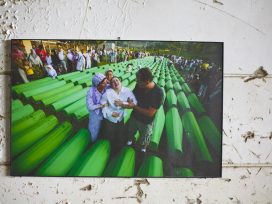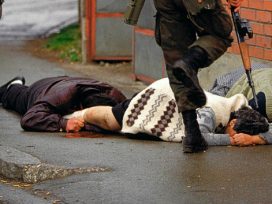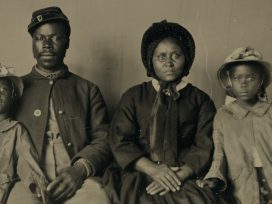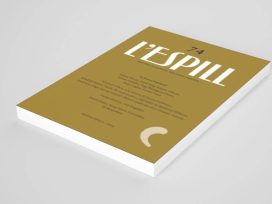This text is based on a presentation made by the author at the Central European Forum in Bratislava on 18 November 2017.
We all think we know what evil is – and what it looks like. We have enough examples from history, both from recent history and even from the present day. But in order to illustrate what we are talking about today, it seems to me useful to take another look at it – and I mean literally so.
The concept of evil is ancient, and all religions include in their first sets of rules instructions on how to fight it. Interestingly, we have not come up with a better, more appropriate concept to this today.
Let’s turn to the photo by Ron Haviv here: what do we see?
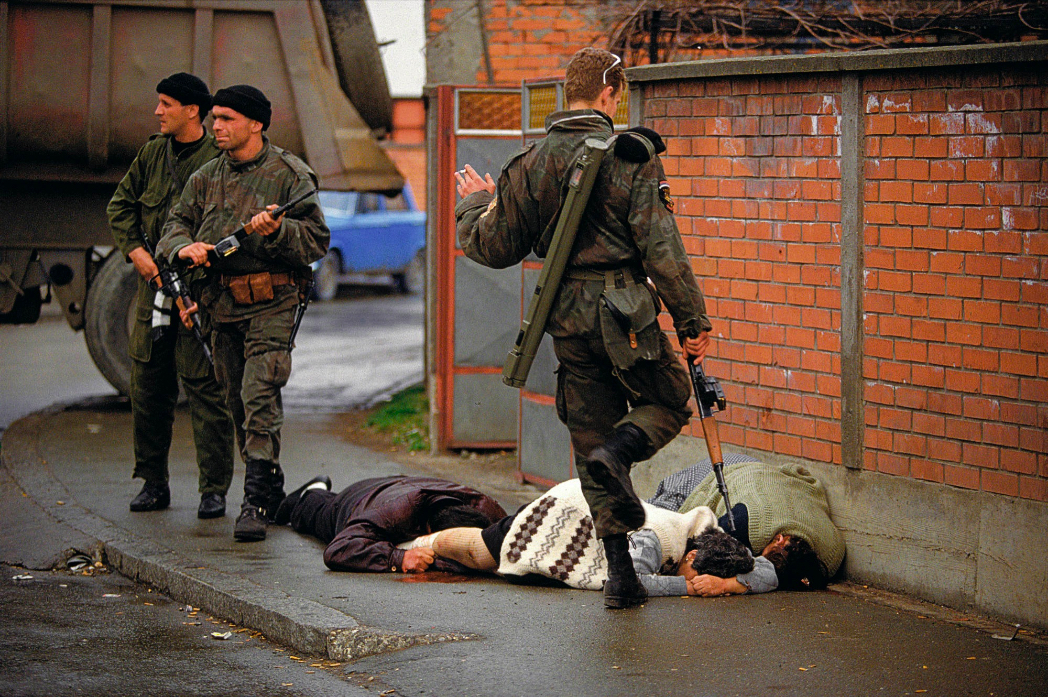
Photo: Ron Haviv. Source: Courtesy of Ron Haviv/Biography of a Photo
A soldier kicking the bodies of dead or dying civilians. It is initially hard to detect the soldier’s insignia or nationality from the photo, but we know that it was taken on 2 April 1992 in Bijeljina, Bosnia. The uniformed men are Serbian paramilitaries, Arkan’s ‘Tigers’, on a killing spree against the Muslim citizens of that small town – what later became known as ‘ethnic cleansing’. It was very effective: only 10% of the original Muslim population was left in that region after the war.
I do not remember where I saw this image for the first time – whether it was in some foreign newspaper, or someone pointed it out to me – yet it stayed with me, in me. In 2003, when Predrag Lucić, the editor of Feral Tribune, a small publishing house in Croatia, suggested we put it on the cover of my book on war criminals, They Would Never Hurt a Fly, I, of course, agreed – despite knowing only too well that not many readers in my country would reach for a book with such a cover. Indeed, publishers in the 15 countries where it was later translated did not accept the photo as a cover image. They were appalled by the idea.
However, this same photo was selected, by Time magazine and an international team of curators, to be among the 100 most influential photographs of all time.
What I do remember well is how I felt watching the photo that first time: the sudden lack of air, as if I had forgotten to breathe for a moment; the void it created in my chest; and the dismay that it created in my mind when my eyes met the two women and the man lying on the asphalt, blood oozing from under them.
Maybe it was because of that woman. Note that the woman in a white hand-knitted pullover, whom the soldier is about to kick, has her hands folded above her head; if you are not careful, you might ignore that gesture or even think – foolishly! – that she is pretending to be dead or hiding her face. But when you take another look, when you pay attention, you can see that it can only be a hopeless attempt to protect herself from ending up like the woman next to her. Her neighbour’s head is cracked, you can see the open wound above her ear; the ground beneath is still wet from her blood.
Now let us turn to the left-hand side of the photo for a moment: it looks as if the situation on the left-hand side has almost nothing to do with what is happening on the right. Two soldiers in paramilitary uniforms are passing by the bodies on the ground. They look ahead, paying no attention to what their companion is doing. The two parts of the same photo could stand apart, even though one of the soldiers has almost stumbled over the foot of the dead man, so close are they. Judging by the way they are holding their guns, they look as if they are searching for more civilians to kill. According to the ICTY, before which this same photo was used as evidence by the prosecution, on that day alone they killed between 48 and 78 Muslim civilians, but are suspected of killing many more: between 250 and 1,000.
So, really, why should they bother about those who had already been killed?
It is precisely this imbalance – between their detachment and his engagement – that directs our attention back to the soldier about to kick the woman with his right boot.
He, or rather his gesture, exudes a variety of emotions. It is easy to read them: even students in high schools and colleges, when seeing the photo (as they do as part of a documentary, Biography of a Photo, that the photographer and co-director Lauren Walsh are currently filming, trying to understand what other people see in his photo), recognise in his aggression his anger, fury, contempt, hatred.
Yet, that is not all that one can see here.
Because – again, you have to look carefully – somewhere in the middle of it, there is a tiny detail that is actually the most telling of all, the key to the whole scene. In his left hand, the kicking soldier is holding a cigarette butt. It is almost invisible, but it is there.
This cigarette butt is telling us, the viewers, a background story. It is telling us that the soldier, while smoking and walking, perhaps taking a break from the killing (you cannot shoot people non-stop; you need a pause) – makes a detour in order to stop and kick these people on the ground. Evidently, even during his break, he could not resist the impulse to hit out at their bodies, even though the job is done – they are dead.
We can see that he is making an additional effort, he is performing an extra act of violence. Why? Is it because for him the enemy is not dead enough? No, it’s because it is not enough that the enemy (no longer a person!) is dead; they must be humiliated in death. He needs to kick the dead person as he would a dead dog, angry because the animal had barked at him or bit him. Except that you don’t kick people, unless you believe they are dogs.
This is exactly what is happening here, he is kicking them, and by that act of excessive violence he is turning them into dogs, garbage, nothing.
And that cigarette in his hand is what betrays him; he is out to humiliate and desecrate in his ‘free time’, which makes his behaviour even more appalling.
Is this the end? No, the cigarette butt reveals yet more, something personal in his attitude to dead bodies. That soldier behaves as if he knows the dead people he is kicking.
And, in a way, he does. They speak the same language, they lived in the same country, he likes their food, knows well their habits and ways of being. Perhaps in his town he went to school with some Muslims. Some of them were his friends. In a way, they are so close to him that he can’t be indifferent, he can’t control his feelings.
This fact makes him even more angry and violent.
But what if the woman in the knitted pullover is only pretending to be dead? What if the soldier is just checking if the civilians on the pavement are trying to fool him? After all, he has to make sure. If this were a photo of a routine check, would it be less horrifying?
Ron Haviv’s photo is a picture of war, any war. All the ingredients are here. But also of a civil war, of people who lived too close to each other not to kill one another with emotions.
The soldier could have passed by, like the other two. But he did not. Instead, he made a choice to express his fury, maybe – who knows? – even his own unconscious despair, by breaking another big taboo, that against violating the body of a dead human being.
No doubt, this is a picture of evil, as an act of ‘collective identity’, according to Stanford prison experiment author Philip Zimbardo.
Or a picture of the other side of human nature, or human potential, which has the capacity for both good and evil.
This is an illustration of what we are dealing with in this discussion.
This is what we need to change.




